1000
Asia Pacific J Clin Nutr (1996) 5(4): 239-243
Asia Pacific J Clin Nutr (1996) 5(4): 239-243

Glycaemic and insulin responses
of diabetic patients to traditional Malaysian meals and the effect
of guar gum
Bin AK Khalid PhD, FRACP, Lai-Fun Lee BSc, Abu Hassan Samad MRCP, Mee-Lian Ng* PhD
Departments of Medicine and Biochemistry*
Universiti Kebangsaan Malaysia, Kuala Lumpur, Malaysia.
The aims of the project were to determine the glycaemic
and insulin responses of non-insulin dependent diabetic patients
(NIDDM) to 3 traditional Malaysian meals compared to oral glucose,
and to determine whether guar gum would affect these responses.
Patients with NIDDM were tested with 75 g oral glucose and three
common breakfast meals of the three main ethnic groups of Malaysia.
When compared with the oral glucose group, significantly by lower
blood glucose responses were seen at 90 and 120 minutes post prandial
for nasi lemak (p<0.05) and at 60, 75 and 90 minutes for mee
sup (p<0.05). No significant difference was seen for roti telur.
There was no significant difference in plasma glucose at any time
point of the study when the three test meals were compared with
each other. Addition of 5g granulated guar gum mixed with water
taken prior to the glucose significantly lowered the plasma glucose
at 60, 120 and 150 minutes postprandially (p<0.05). Similarly
for the test meals, guar gum significantly lowered plasma glucose
concentration between 15 and 45 minutes (p<0.03) postprandial
for nasi lemak and between 15 and 30 minutes (p<0.03) for mee
sup but not with roti telur. With addition of guar gum, there was
no significant change of insulin responses with the three meals
but a significant increase was seen at 30 minutes (p<0.02) after
ingestion of glucose.
Key Words: Diabetes, nutrition,
breakfast, Malaysian, guar gum, glycaemic index, insulin, sugar
Introduction
Guar gum is a form of dietary fibre which is obtained
from endosperm of the Indian cluster bean, Cyamopsis tetragonoloba.
It is used widely as an animal feed, in the food industry as a thickening
and emulsifying agent and in pharmaceutical production as an additive
to tablets. It was first suggested to have a possible role in the
management of diabetes by Jenkins and colleagues1 in 1976.
Most1-8 studies, but not all9, showed
a reduction of fasting blood glucose levels and/or glucose insulin
responses to a test meal. These studies had been done on Western foods
which were obviously different from Asian foods. Malaysia is a multiracial
Asian country with a good variety of foods. Rice is the staple while
dough/bread and noodles are also popular among the locals. In comparison
to Western meals, in general, local 1000 Malaysian meals are higher
in carbohydrate which is more unrefined.
| In previous studies,
guar gum has been administered as pre-meal aqueous drinks5,10-14
or mixed into a food14-15. To our knowledge,
no local Malaysian test meals have been evaluated with guar gum.
The present study was designed to investigate the glycaemic and
insulin responses of Malaysian diabetic patients taking the three
common ethnic breakfast meals and to determine whether guar gum
has any significant effect in altering these responses.
A common meal for Malays is nasi lemak, for Chinese mee sup,
and for Indians roti telur. Nasi lemak consists of rice cooked
in coconut milk with sambal ikan bilis (dried anchovies cooked
in chili paste), fresh cucumber, fried groundnuts, fried dried
anchovies and half of a hard boiled egg. Roti telur is a traditional
Indian-style pancake fried with an egg served with dhal curry.
Mee sup consists of noodles (mee), egg, cabbage, mustard leaves,
tomato and sliced chicken meat. The compositions of the meals
calculated from the food composition table16 are
shown in Table 1.
|
Table 1. Composition of test
meals
| Test Meal |
Energy
|
Protein
|
Fat
|
Carbohydrate
|
| |
(kcal)
|
(kJ)
|
(g)
|
(g)
|
(g)
|
| Nasi lemak |
570
|
(2386)
|
31
|
29
|
45
|
| Roti telur |
525
|
(2198)
|
19
|
20
|
67
|
| Mee sup |
640
|
(2679)
|
20
|
24
|
85
|
Nasi lemak (Malay): Rice in coconut milk (160g),
anchovies in chili (30g), fried anchovies (15g), cucumber (15g),
groundnuts (15g), half-boiled egg (25g).
Roti telur (Indian): Fried pancake with an egg (165g), dhal
curry (120g).
Mee sup (Chinese): Wheat noodles (180g), egg (50g) chicken (20g),cabbage
(30g), mustard leaves (10g), tomato (30g).
|
Materials and methods
In the first part of the study, non-insulin dependent
diabetes mellitus (NIDDM) volunteers were recruited from the Endocrine
Clinic, Universiti Kebangsaan Malaysia. They were free from other
major illness and were between 30 and 75 years of age. Eleven NIDDM
(9 men, 2 women) of mean age ± standard deviation 43.5± 12.6 years
and mean body mass index (BMI) of 25.2 ± 3.7 kg/m were studied.
After an overnight fast without taking the usual hypoglycaemic
drugs, an indwelling catheter was inserted in an antecubital vein
for collection of blood samples. An oral glucose tolerance test (OGTT)
using 75g glucose diluted in a glass of water was performed. Two basal
blood samples at -15 and 0 minutes were collected before the meal
followed by blood samples taken 7.5, 15, 30, 45, 60, 75, 90, I20,
150 and 180 minutes after the meal. On the following day, 5g of granulated
guar gum preparation (Guarem®, Finland) mixed in a cup
of water was consumed immediately before the oral glucose load meal
was given.
In the second part of the study, groups of 6 to 10
subjects from a pool of 12 NIDDM (9 men, 3 women) were recruited.
They were of mean age 56.8 ± 13.3 years and of mean body mass index
of 23.3 ± 2.9 kg/m2. Six subjects completed all the three
test meals. Three of the 12 NIDDM were treated with diet only, while
nine were on sulphonylurea only or with metformin. The subjects were
in fairly good diabetic control with fasting plasma glucose ranging
from 5-12 mmol/l. The procedure used for the glucose tolerance test
was repeated.
Three common ethnic breakfast meals were given following
the overnight fast, and the blood samples as for the glucose tolerance
test were taken. The whole procedure of testing the three different
meals with or without guar gum were conducted with at least a week
between each 1000 type of meal.
Blood samples collected in heparin tubes for glucose
analysis were separated immediately and the plasma stored before analysis.
Sera obtained for insulin were stored at -20°C until assayed. Blood
glucose was measured by glucose oxidase method using a Beckman analyser
(Beckman® Instruments, USA) while serum insulin was measured
by radioimmunoassay using a commercial kit (NOVO®, Denmark).
The intra-assay coefficient of variation for glucose was 5% and for
insulin was 15%. Results are expressed as mean ± standard error of
means (SEM) and analysed by student’s paired t-test or analysis
of variances (ANOVA) where appropriate.
Results
The OGTT group and test meals group were not comparable
in age and weight, but each group formed its own control for guar
gum. Comparison between test meals were made for six NIDDM who completed
all the three test meals.
| Figure 1.
Glycaemic responses of diabetic patients to different test meals
and oral glucose load. Values are mean±SEM (n=6), * p<0.05
compared to OGTT (n=11). |
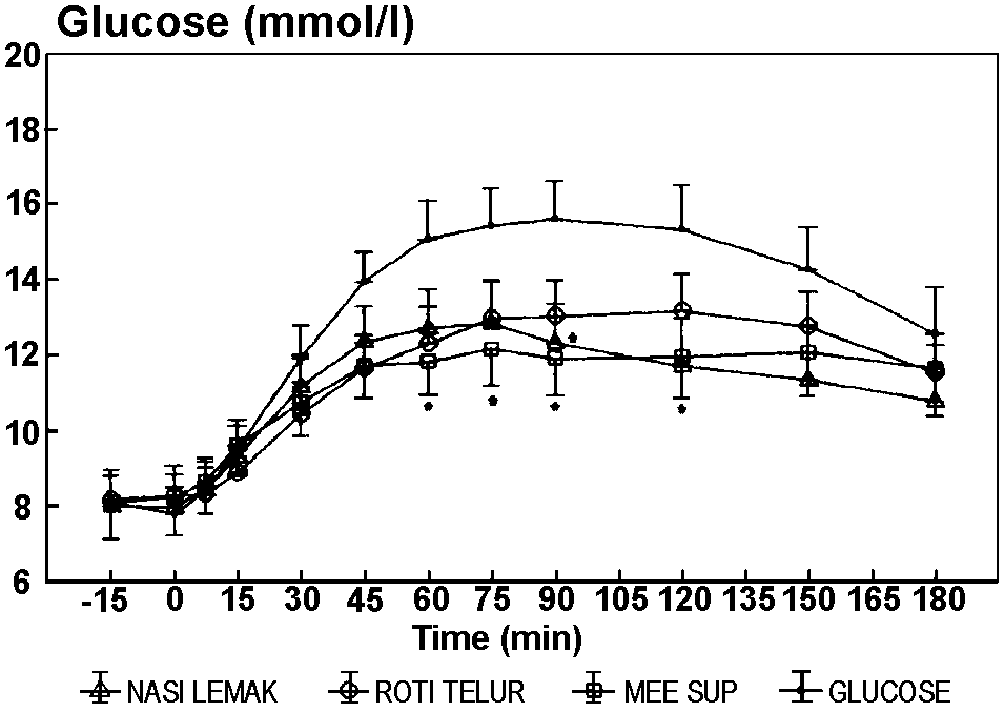 |
| In Figure 1, when the
glycaemic responses for the six subjects who completed all the
three test meals were compared with the OGTT glycaemic responses,
significant differences (lower for test meal) were seen at 90
and 120 minutes for nasi lemak (p<0.05) and at 60, 75 and 90
minutes for mee sup (p<0.05). No significant difference was
seen for roti telur.
When comparing the mean individual peak plasma
glucose level with the glucose group, all three test meals had
significantly lower levels (p<0.05), but there was no significant
difference in mean peak plasma glucose time.
Among the three test meals, there were no significant
differences in the plasma glucose levels for any time point
of the study. Mean peak plasma glucose time for mee sup was
achieved significantly later than nasi lemak (p<0.05) (Figure
1).
When subjects took 5g of guar gum immediately
before the glucose drink, the mean peak plasma glucose level
was reduced by 1.4 mmol/1 and occurred significantly earlier
(p<0.03) (Table 2). Glucose concentrations tended to be lower
with the administration of guar gum but this was statistically
significant only at 60 min (p<0.05), 120 min (p<0.05)
and 150 min (p<0.01) (Figure 2).
A similar pattern was seen when the nasi lemak
test meal was preceded by consuming guar gum (Figure 3). There
was no significant decrease in mean peak plasma glucose levels.
The mean peak glucose level, however, was significantly delayed
(p<0.002). Significantly lower mean plasma glucose occurred
at 15 minutes (p<0.05), 30 minutes (p<0.05) and 45 minutes
(p<0.01).
There was significant change in the mean peak
plasma glucose levels and the mean peak times for both mee sup
and roti telur meals with the addition of guar gum (Table 2).
The mean plasma glucose concentration decreased significantly
at 15 minutes (p<0.03) and 30 minutes (p<0.01) for mee
sup when subjects were given guar gum (Figure 4). There was
no 1000 significant decrease in plasma glucose levels when guar
gum was consumed prior to roti telur (Figure 5).
|
Table 2. Peak plasma glucose
and peak time achieved after meals with or without guar gum
| Type of Meal |
Glucose concentration
mean±SD
(mmol/l)
|
Time
mean±SD
(min)
|
| Glucose load
(n=11) |
|
|
| without guar gum
|
16.6±3.6
|
95.4±27.3
|
| with guar gum
|
15.1±2.3
|
77.7±14.0*
|
| Nasi lemak
(n=10) |
|
|
| without guar gum
|
13.4±2.6
|
67.5±15.4
|
| with guar gum
|
13.2±2.0
|
111.0±39.8**
|
| Roti telur
(n=7) |
|
|
| without guar gum
|
13.0±2.2
|
98.6±29.8
|
| with 1000 guar
gum |
13.0±2.1
|
122.1±28.2
|
| Mee sup (n=8) |
|
|
| without guar gum
|
12.2±2.6
|
106.9±47.7
|
| with guar gum
|
11.8±2.6
|
118.1±38.6
|
Values significantly different from those taken
without guar gum * p < 0.03, ** p < 0.002
|
| Figure 2.
Glycaemic responses of diabetic patients to 75g oral glucose load
with and without guar gum. Values are mean±SEM (n=10), *p<0.05;
** p<0.01; *** p<0.005. |
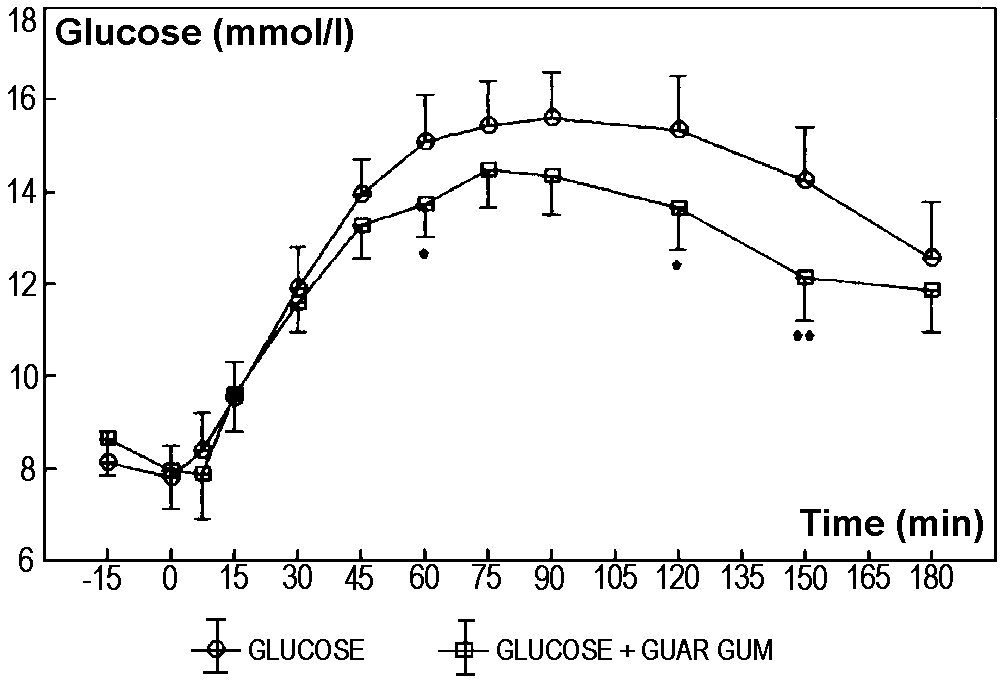 |
| Figure 3.
Glycaemic responses of diabetic patients to nasi-lemak test meal
with and without guar gum. Values are mean±SEM (n=10), * p<0.05;
** p<0.01; *** p<0.005. |
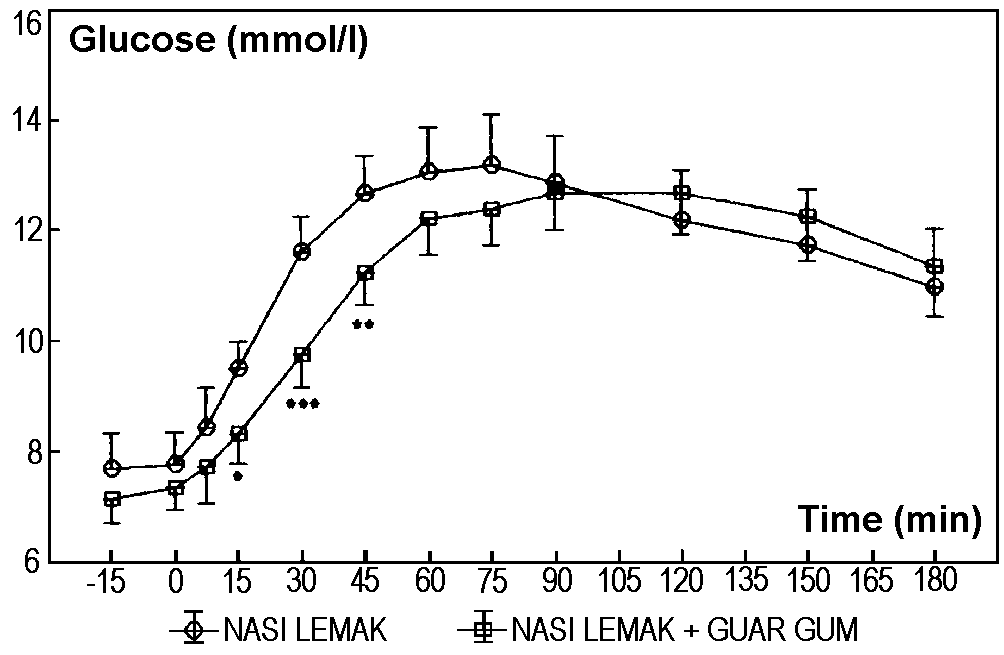 |
| Figure 4.
Glycaemic responses of diabetic patients to mee sup test meal
with and without guar gum. Values are mean±SEM (n=8), * p<0.05;
** p<0.01. |
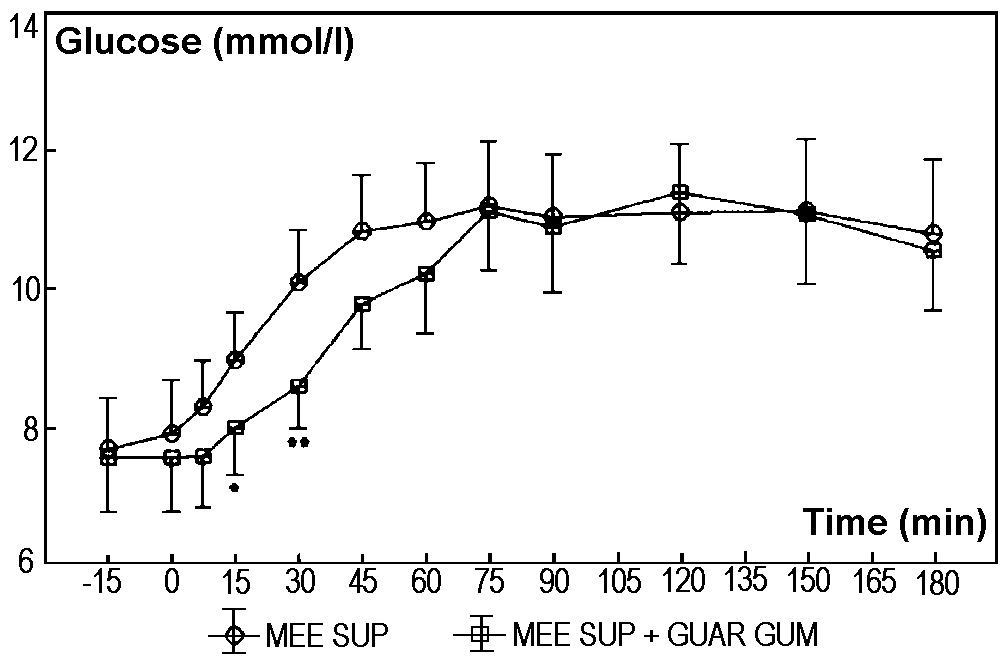 |
Serum insulin concentration tended to be greater when
guar gum was taken with a large load of glucose (Figure 6) but this
was only significant at 30 minutes for oral glucose load (p<0.02).
No significant differences were seen in the mean serum insulin levels
at different time points for the three test meals when guar gum was
given compared to without guar gum (data not shown).
| Figure 5.
Glycaemic responses of diabetic patients to roti telur test meal
with and without guar gum. Values are mean±SEM, (n=7). |
|
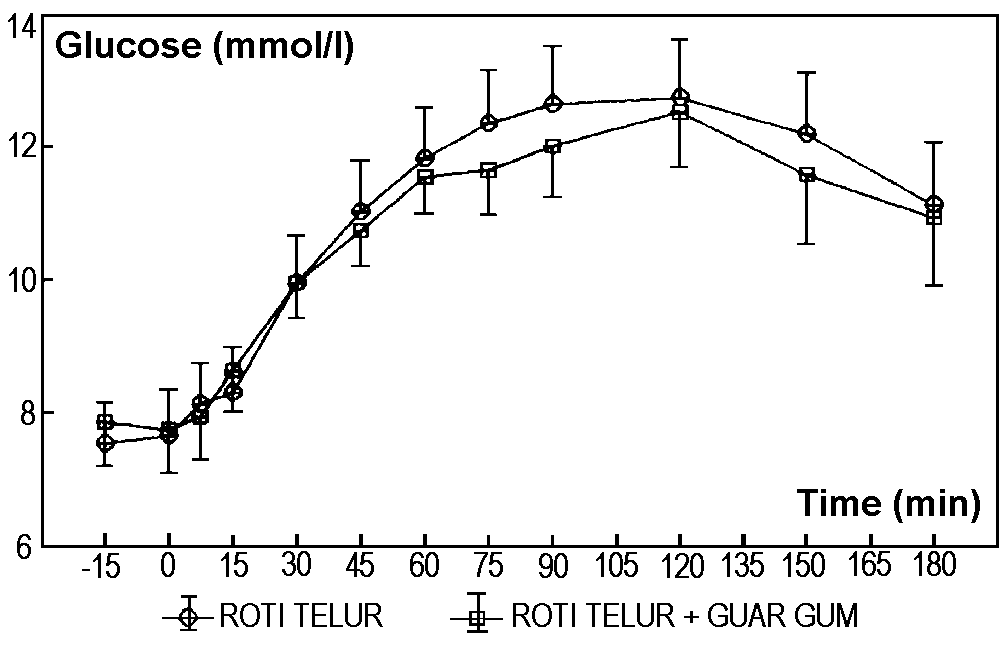
|
| Figure 6. Serum insulin responses
of diabetic patients to 75g oral glucose load with and without
guar gum. Values are mean±SEM, (n=11), * p<0.02. |
|
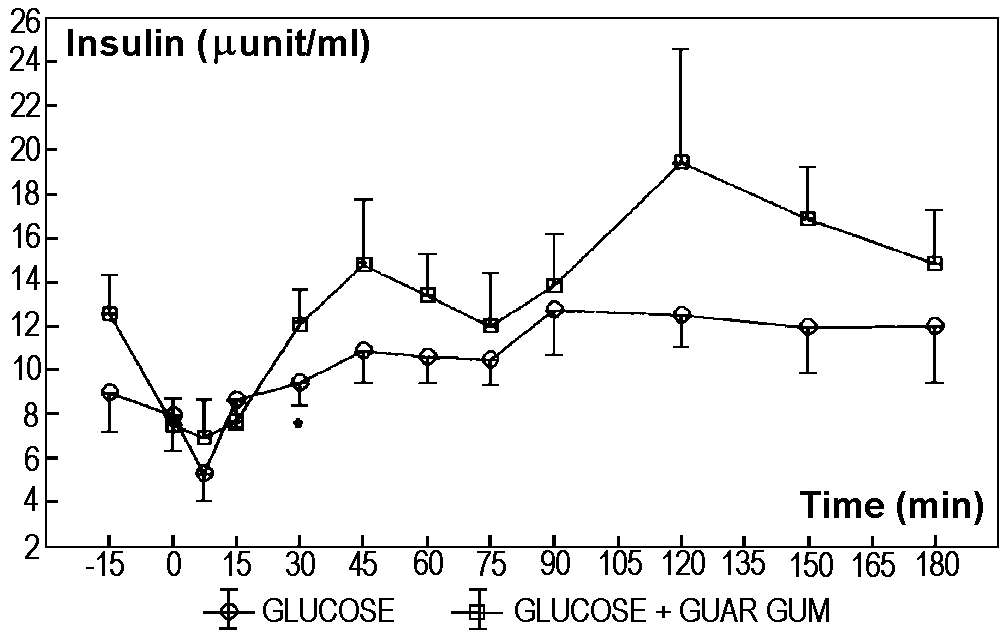
|
Discussion
Only results of the six subjects who completed all
three test meals were used to make comparisons for the three test
meals. When compared with OGTT, which contained solely simple carbohydrate
(75g glucose), only nasi lemak (45g carbohydrate) and mee sup (85g
carbohydrate) yielded significantly lower glucose concentrations.
Despite the differences in carbohydrate content, ranging from 45 to
85g, the plasma glucose concentrations were not significantly different
among the three meals. This suggests that NIDDM patients need not
adhere to strict carbohydrate exchanges to achieve similar postprandial
plasma glucose concentration if the total difference of carbohydrate
of the meal does not exceed 40g for these mix meals. In contrast to
an earlier study17 that reported similar glycaemic responses
of mixed meals with the same contents of carbohydrate, protein, fat
and energy, our study shows that these effects can be obtained with
normal serves of test meals of different composition.
This study also shows that not all local breakfast
meals tested resulted in lower plasma glucose responses when guar
gum was administered prior to the meal. Roti telur, which is a dough
fried with an egg, did not show any difference in glycaemic responses
when guar gum was added. The reason for this is uncertain and possibly
is that the contribution that guar could make has already been made
by the dhal in roti telur.
Guar should ideally be intimately mixed with carbohydrate
as timing is critical for its effectiveness. The action of guar gum
on carbohydrate is explained by its marked gel-forming capacity and
the resulted delayed emptying of the stomach and delayed intestinal
absorption of nutrients. The viscosity of the gel attained is dependent
on time, temperature and pH11. However, as a good number
of local Malaysian meals consists of wet meals like curries, porridges
or soups it would be rather unpalatable due to the viscosity of guar
gum if it were pre-mixed into the meal. For this reason, in this study
guar was administered as a premeal drink instead.
The mean plasma glucose concentration when guar gum
was consumed prior to nasi lemak or mee sup was significantly less
than the control at earlier time points, that is between 15 and 45
minutes after meal. This suggests a delay in the absorption of digested
carbohydrates. When guar gum was given prior to glucose load, significantly
lower plasma glucose levels were achieved later at 60, 120 and 150
minutes. Since glucose does not require digestion for absorption,
the differences in time of significant glucose lowering can only be
attributed to some effect of guar gum on the digestion of carbohydrate
in nasi lemak and mee sup. No similar effect, however, was observed
with the roti telur test meal.
In some studies when guar gum was taken separately
as a premeal drink before a glucose load18 or a meal13,
no significant effect on glycaemic response was reported. However,
in our present study, significant decreases in glycaemic responses
were shown with nasi lemak and mee sup test meals, but not with roti
telur when guar was pre-fed to diabetic subjects. Although guar gum
was effective in decreasing the rate and delaying the peak time for
glucose absorption1-8 it did not lower peak glucose levels
for the three test meals. Thus, results obtained from studies on Western
meals cannot b 1000 e extrapolated to local settings. Other types
of traditional Malaysian meals have not been tested, however, and
the limited sample size make caution advisable in the interpretation
of the effectiveness of guar gum. Of particular interest is the question
of how difference in serving size, for a particular ethnic breakfast,
might allow lower peak plasma glucose responses. There is also a need
for further studies to be done to investigate the effectiveness of
guar gum in longer term studies in local diabetic patients.
Acknowledgments:
This project was funded by Universiti Kebangsaan Malaysia
research grant 17/88 and Biotechnology Research grant BU 4 from the
Ministry of Science and Technology. We thank Orion Pharmaceutical,
Finland for the supply of Guarem and Nurshireen Abdullah for her technical
help.
Glycaemic and insulin responses
of diabetic patients to traditional Malaysian meals and the effect
of guar gum
Bin AK Khalid, Lai-Fun
Lee, Abu Hassan Samad, Mee-Lian Ng
Asia Pacific Journal of Clinical
Nutrition (1996) Volume 5, Number 4: 239-243
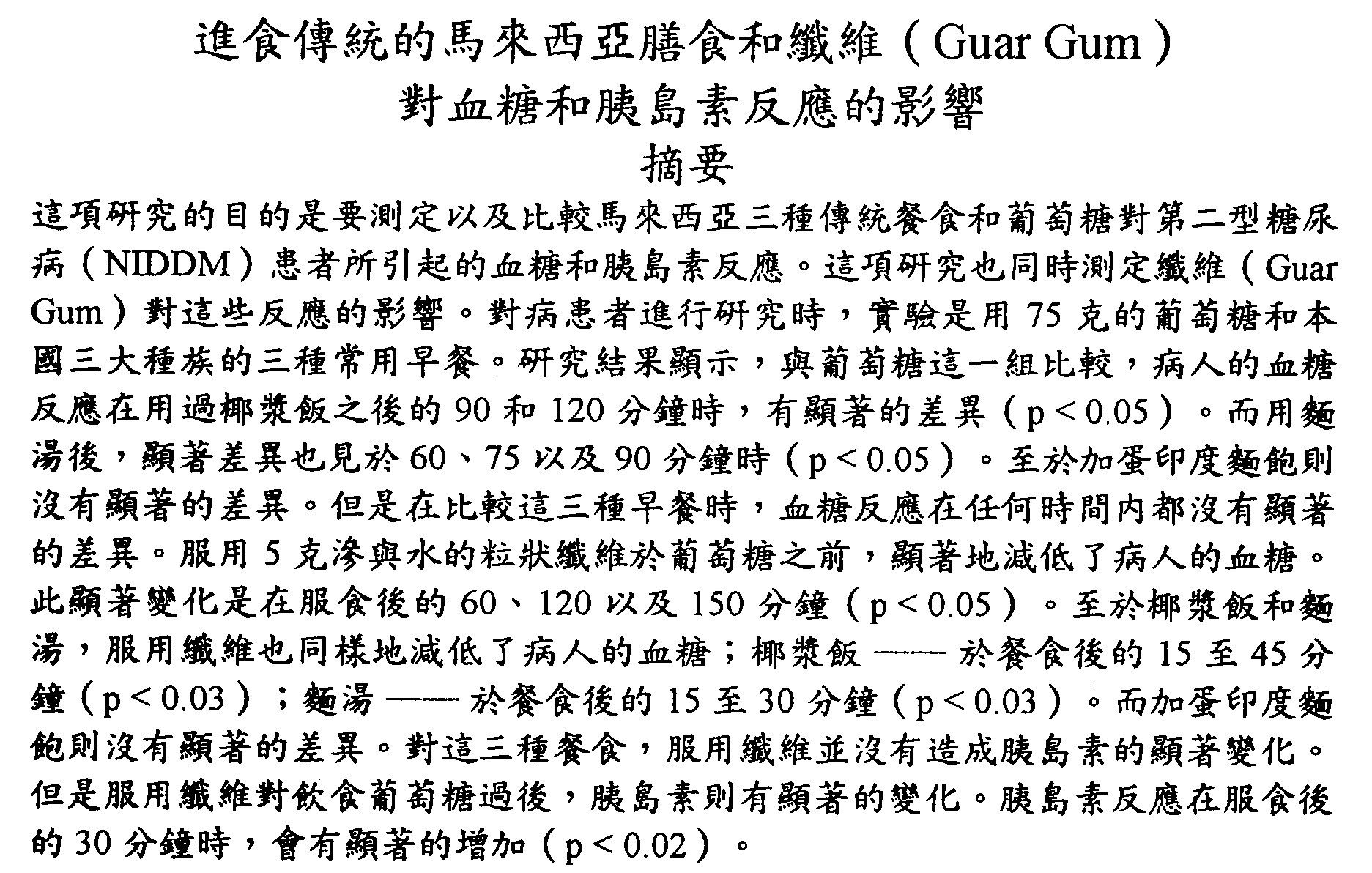
Glycaemic and insulin responses
of diabetic patients to traditional Malaysian meals and the effect
of guar gum
Bin AK Khalid, Lai-Fun
Lee, Abu Hassan Samad, Mee-Lian Ng
Asia Pacific Journal of Clinical
Nutrition (1996) Volume 5, Number 4: 239-243
Tujuan projek ini ialah untuk menentukan tindakan
glisemik dan insulin bagi pesakit-pesakit diabetik tidak bergantung
insulin (NIDDM) terhadap 3 makanan traditional Malaysia berbanding
dengan glukosa oral serta untuk menentukan kesan guar gum terhadap
tindakan-tindakan ini. Pesakit-pesakit NIDDM telah diuji dengan 75g
glukosa oral dan 3 jenis sarapan pagi menurut kumpulan etnik utama
Malaysia.
Perbezaan ketara telah diperhatikan terhadap tindakan
glukosa pada 90 dan 120 minit selepas memakan nasi lemak (p<0.05)
dan pada 60, 75 dan 90 minit selepas memakan mee sup (p<0.05) bila
dibandingkan dengan kumpulan glukosa oral. Namun, tiada perbezaan
ketara diperhatikan untuk kumpulan yang memakan roti telur. Tidak
terdapat perbezaan yang ketara bagi glukosa plasma pada kesemua poin
masa kajian ini bila ketiga-tiga makanan ujian ini dibandingkan antara
satu sama lain.
Penambahan campuran 5 g granul guar gum dengan air
yang diambil sebelum glukosa oral telah dapat merendahkan glukosa
plasma pada 60, 120 dan 150 minit posprandial (p<0.05). Dengan
cara yang sama untuk ujian makanan, guar gum didapati merendahkan
glukosa plasma dengan ketara antara 15 dan 45 minit (p<0.03) posprandial
untuk nasi lemak dan antara 15 dan 30 minit (p<0.03) untuk mee
sup tetapi tidak untuk roti telur.
Penambahan guar gum tidak memberi kesan yang ketara
terhadap tindakan-tindakan insulin untuk ketiga-tiga jenis makanan
tetapi perbezaan yang ketara diperhatikan pada 30 minit (p<0.02)
selepas pengambilan glukosa.
References
- Jenkins DJA, Goff DV, Leeds AR, et al. Unabsorbable
carbohydrates and diabetes:- decreased post-prandial hyperglyeaemia.
Lancet 1976; 2:172.
- Gassull MA, Goff DV, Haisman, et al. The effect
of unavailable carbohydrate gelling agents in reducing postprandial
glycemia in normal volunteers and fe8 diabetics. J Physiol Lond
1976; 259:528.
- Jenkins DJA, Leeds AR, Gassull MA, et al. Decrease
in postprandial insulin and glucose concentrations by guar and pectin.
Ann Intern Med 1977; 86:20.
- Jenkins DJA, Nineham R, Craddock C, et al. Fibre
and diabetes. Lancet 1979; 1:434.
- Aro A, Uusitupa M, Voutilainen G, et al. Improved
diabetic control and hypercholesterolemic effect induced by long
term dietary supplementation with guar gum in type 2 (non-insulin
dependent) diabetics. Diabetologia 1981; 54:1.
- Smith U, Holm G. Effect of modified guar gum preparation
on glucose and lipid levels in diabetics and healthy volunteers.
Atherosclerosis 1982; 45:1.
- Uusitupa M, Aro A, Korhonen T, et al. Blood glucose
and serum insulin responses to breakfast including guar gum and
cooked or uncooked milk in type 2 (non-insulin dependent) diabetics
patients. Diabetologia 1984; 26:453.
- McIvor ME, Cummings CC, Leo TA, Mendeloff AI. Flattening
postprandial blood glucose responses with guar gum - acute effects.
Diabetes Care 1985; 8:274.
- Holman RR, Steemson J, Darling P, Turner RC. No
glycaemic benefit from guar gum administration in NIDDM. Diabetes
Care 1987; 10:68.
- Jenkins DJA, Wolever TMS, Leeds AR, et al. Dietary
fibre, fibre analogues and glucose tolerance: importance of viscosity.
Br Med J 1978; 1:1992.
- O’Connor N, Tredger J, Morgan L. Viscosity
differences between various guar gum. Diabetologia 1981; 20:612.
- Najemik C, Krits H, Irsiglar K, et al. Guar and
its effects in metabolic control in Type II diabetic subjects. Diabetes
Care 1984; 7:215.
- Fuessi S. Advian TE, Barcarese-Hamilton AJ, Bloom
Sr. Guar in NIDD: effect of different modes of administration on
plasma glucose and insulin responses to starch meal. Practical Diabetes
1986; 3:259.
- Ebeling P, Yki-Jarvinen H, Aro A, Helve E, Sinisalo
M, Koiristo VA. Glucose and lipid metabolism and insulin sensitivity
in type-I diabetes: the effect of guar gum. Am J Clin Nutr 1988;
48:98.
- Van Duyn MAS, Leo TA, McIvo ME, et al. Nutritional
risk high carbohydrate, guar gum dietary supplementation in non-insulin
dependent diabetes mellitus. Diabetes Care 1986; 9:497.
- Tee ES, Mohd IN, Mohd NA, Khatijah I. Nutrient
Composition of Malaysian Foods (ASEAN Food Habits Projects) - preliminary
report, 1988.
- Colaquin S, Miller JJ, Holliday JL, Phela E. Comparison
of plasma glucose, serum insulin and C-peptide responses to three
isocaloric breakfasts in non-insulin dependent diabetic subjects.
Diabetes Care 1984; 9:250.
- Jenkins DJA. Dietary fiber, diabetes and hyperlipidaemia.
Lancet 1979; 2:1287.

Copyright © 1996 [Asia Pacific Journal of Clinical
Nutrition]. All rights reserved.
Revised:
January 19, 1999
.
 to the top
to the top
0